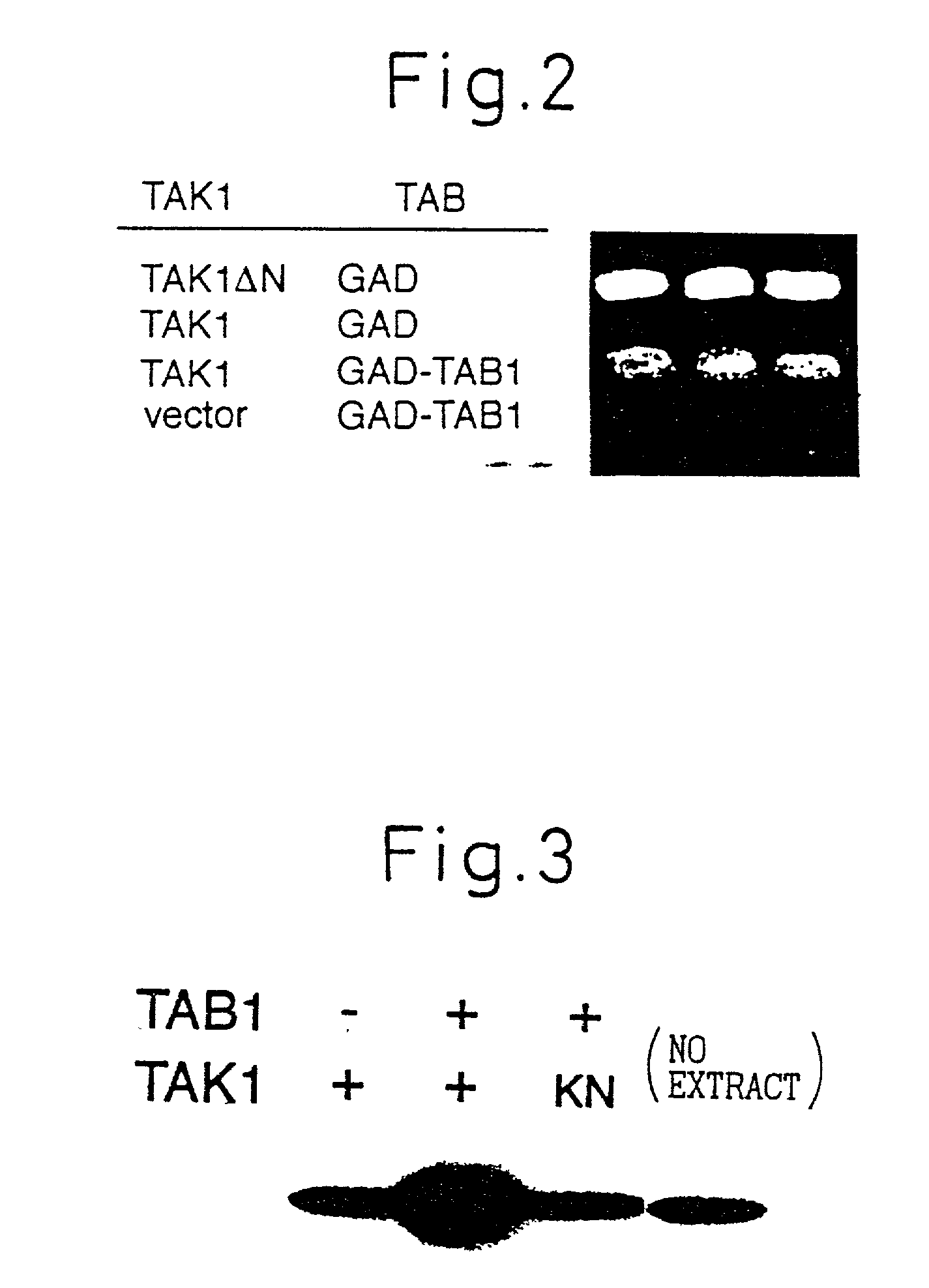TAB1 protein and DNA coding therefore
a technology which is applied in the field of coding and protein of tab1, can solve the problems of pathological fibrosis, inability to repair and reproduce tissues, and little information at the molecular level about the signal-transduction mechanism downstream from the tgf-
- Summary
- Abstract
- Description
- Claims
- Application Information
AI Technical Summary
Benefits of technology
Problems solved by technology
Method used
Image
Examples
example 1
[0045] Example 1
[0046] Analysis of the TAK1-dependent pathway functioning for TGF-.beta. signal-transduction was made using a yeast 2-hybrid system (S. Frelds et al., Trend Genet. 10, 286 (1994)), and a protein having direct interaction with TAK1 was sought.
[0047] First, an expression vector was constructed by linking the TAK1 gene and a gene coding for the LexA DNA-binding domain. pLexA-TAK1.DELTA. contains the TAK1.DELTA.N coding sequence (K. Yamaguchi et al., Science, Vol.270, p.2008 (1995)) inserted in frame into pBTM116 (A. B. Vojtek et al., Cell, Vol.74, p.205 (1993)). A yeast 2-hybrid system was used to identify a protein encoded in a human brain cDNA library and interacting with TAK1.DELTA.N.
[0048] The two hybrids were expressed in Saccharomyces cerevisiae L40 (LYS2:LexA-HIS3) containing an integrated reporter construct with a binding site for LexA protein located upstream from the yeast HIS3 coding region. Interaction between the two hybrid proteins causes transactivation o...
example 2
[0051] A series of LexA-TAK1 deletion chimera were tested by the 2-hybrid method to determine the site in TAK1 which is responsible for interaction with TAB1. An expression vector coding for the full TAK1 or deletion construct thereof fused to the LexA DNA-binding domain was used for simultaneous transformation of the yeast reporter strain L40 together with pGAD-TAB1. The DNA coding for each of the TAK1 deletion constructs was prepared from DNA coding for the full TAK1.
[0052] The aforementioned plasmid pGAD-TABl was obtained by cloning TAB1 cDNA at the EcoRI site of pBS (W. O. Bullock et al., Biotechniques, Vol.5, p.376 (1987)). The interaction between the fused proteins expressed by this plasmid is indicated by the ability of the yeast strain to grow on a plate of SC-HIS medium containing 40 mM 3-AT. The results are shown in FIG. 1. The right side of this graph indicates whether TAK1 or its deletion form interacted with TAB1 (+) or not (-). These results demonstrate that TAB1 inter...
example 3
[0053] A protein interacting with TAK1 may contain both the upstream control region and the downstream target. If TAB1 plays a role in activation of TAK1, then their simultaneous expression would be expected to influence activity of TAK1 in yeast. The present inventors have disclosed a system for assaying mammalian MAPKKK activity in a yeast pheromone-induced MAPK pathway (K. Yamaguchi et al., Science, Vol.270, p.2008 (1995); K. Irie et al., Science, Vol.265, p.1716 (1994)). An activated form of TAK1 (TAK1.DELTA.N) can substitute for Stell MAPKKK activity.
[0054] Specifically, the pheromone-activated MAPK pathway consists of Stell, Ste7, and Fus3 or Kss1 kinases, which correspond to MAPKKK, MAPKK and MAPK, respectively. These yeast protein kinases act sequentially to transduce signals to the transcription factor Ste12, upon which Ste12 in turn activates transcription of mating-specific genes such as FUS1 (I. Herskowitz, Cell, Vol.80, p.187 (1995); D. E. Levin et al., Curr. Opin. Cell...
PUM
| Property | Measurement | Unit |
|---|---|---|
| Fraction | aaaaa | aaaaa |
| Angle | aaaaa | aaaaa |
| Biological properties | aaaaa | aaaaa |
Abstract
Description
Claims
Application Information
 Login to View More
Login to View More - R&D
- Intellectual Property
- Life Sciences
- Materials
- Tech Scout
- Unparalleled Data Quality
- Higher Quality Content
- 60% Fewer Hallucinations
Browse by: Latest US Patents, China's latest patents, Technical Efficacy Thesaurus, Application Domain, Technology Topic, Popular Technical Reports.
© 2025 PatSnap. All rights reserved.Legal|Privacy policy|Modern Slavery Act Transparency Statement|Sitemap|About US| Contact US: help@patsnap.com



